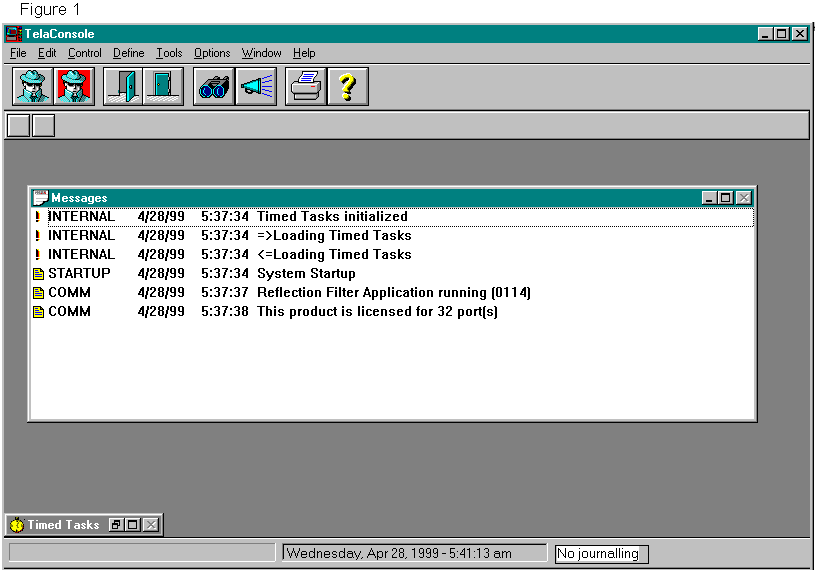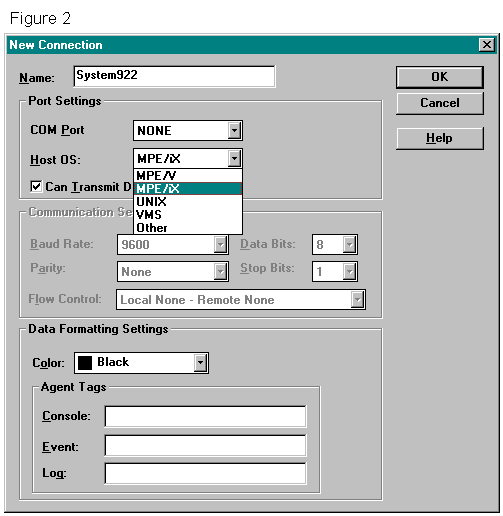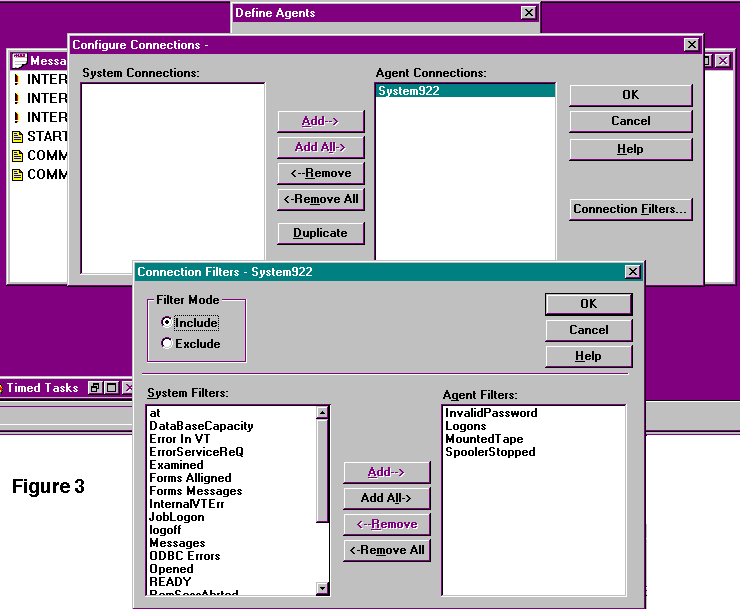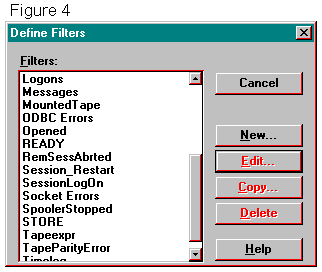TelaConsole tracks
devices in 3000 shops
Software/hardware
solution eliminates need to scan all consoles in datacenters
Review by Shawn Gordon
TelaConsole is software
(and optional hardware, if required) that allows you to connect multiple
devices such as your HP 3000 host computer, multiport engines, or any
device capable of transmitting a serial signal, all to a single PC for
management and reporting. TelaConsole eliminates the need to constantly
visually scan all the consoles and devices in your computer center. Since
all messages that go to the console are stored, there is never the
possibility of missing a message because it scrolled off the screen.
TelaConsole’s features allow you to:
1. Track all console messages — or only those you
choose to see.
2. Filter out repetitive, non-informational messages and
give the operators only what they need to perform their jobs.
3. Consolidate critical messages into a single window.
4. Create automatic responses to certain messages.
5. Scan console logs to find out when certain events
occurred.
6. Optimize operator efficiency by providing online,
user-written procedures to access when problems occur.
7. Create timed tasks that perform commands on host systems
at intervals that you can define.
8. Broadcast commands to the host systems based on any
triggering event, including time.
How does it work?
Depending on how many ports you want to hook up, you can
either use the serial ports on the PC, or use a Multiport Expansion Board.
The TelaConsole manual goes into great detail on installing a DigiBoard for
this purpose.
I simply used the serial ports on the PC to hook up two HP
3000s. In this configuration, you simply have a splitter from the console
cable coming from your 3000. One end connects to the physical console, and
the other end connects to the PC running TelaConsole. Once properly
connected, you are ready to start letting TelaConsole grab your
information.
Once the data stream is coming into TelaConsole, you are
able to apply your various agents, filters, and logging, which I will
describe in a moment. Figure 1 shows a snapshot of the application’s
main startup screen.

Features
TelaConsole is built around the following concepts:
Connections: This is the driving force behind TelaConsole,
where you can name and define the ports and communications defaults. Later
you can assign Agents and Filters to this Connection. See Figure 2 for an
example of what can be configured.

Console Agents: This
agent is the direct connection to the input flow from the console. It
monitors all messages that would normally go to the system console, and
when used in conjunction with filters, it can be adjusted to display only
those messages that are important for the operator to see, such as REPLIES
and security violations. See Figure 3 for an example of a Console Agent
where I’ve applied filtering.

Log Agents: The log
file is the permanent storage site for messages. By utilizing filtering,
this can show either the entire stream coming to your console or something
totally different containing just the information you requested.
Event Agents: These are designed to alert the operator that
a significant event has occurred. As TelaConsole scans each message that
comes in from the console, it determines if the message meets any of the
criteria that you have defined. If the message meets any criteria,
TelaConsole places information in the event agent concerning the
message.
Filters: These are used to trap messages that can either be
routed to an event agent or excluded from the console. Filters are assigned
at a connection level so that they are sitting above the agents to provide
maximum flexibility.
Filters are one of the most powerful features of
TelaConsole. By making use of the sophisticated token feature, you can
re-order and parse messages that come in, putting them into a different
display format. You can even assign colors so that certain types of
messages will stand out in your display. Figure 4 shows an example of some
of the types of filters you can select from.

TelaConsole has been
set up to be very modular. This takes a little getting used to for some
people, but it provides great flexibility. Think of each of the Agents and
Connections as objects. You really need to create Connections first, but
you can create as many as you need. Next you can create your various types
of Agents, and apply whatever filtering you need.
When you create an Agent, you can select one or more
connections for it to apply to. Each connection can have any number and
type of Agent applied to it. This allows you to define global reusable
Agents, and also to create connection-specific agents as required. The more
you think about it and work with it, the more you will start to abstract
your requests so that they apply at a more macro level. This is a very cool
feature.
Installation and Documentation
The software installation is quite easy, as it is wholly
resident on the PC. The only real challenge can be in physically connecting
the splitters to the console cables. If pins 2 and 3 are crossed it can be
a big challenge which kind of cable is which. Telamon attempts to address
this issue by including every type of tester, null modem adapter cable
terminator known to man. This helps make the process pretty painless, but
sometimes it will take a little trial and error on your part to get it
right.
The documentation weighs in at 85 pages and is very well
written and easy to read, with lots of screen snapshot examples. Even the
rather complex section on implementing regular expressions and using the
token feature is written to minimize misunderstandings. While the manual
has a table of contents, there is no appendix. The manual is organized well
enough that this wasn’t a problem.
The TestDrive
I had just a bit of a challenge getting the hardware right,
but got it resolved quickly. Telamon is very responsive and knowledgeable.
I hooked up two HP 3000s to get a feel for the multi-machine workings of
the product. The connections were easy to configure, and agents were easy
to create and apply.
I basically went through and created agents and applied
them in a sporadic fashion to see if there was anything that might break
the product. I was never able to generate a crash in TelaConsole, so
that’s good news. The more I worked with the product, the more ideas
it gave me.
Configuring TelaConsole is an evolutionary process. I found
that you don’t want to get mired down trying to think of everything up
front. Just start working with it and applying agents, and as issues come
up, apply more of them. Eventually you will probably get to a point where
you will rarely make changes in the configuration.
I really found the filtering useful in creating a log of
LOGON and LOGOFF records which allowed me to trace logon times for certain
sessions. Being able to send an event back to the HP based on messages was
also very handy.
I didn’t make use of the expression parsing on
filters, but as long as you can do what the manual indicates, you have a
very powerful tool for scanning, parsing, and reformatting any line of text
that comes through. These are Unix-style standard expressions, which can be
fairly confusing, but the manual does a credible job of explaining them.
There are a lot of options and permutations you can go
through because of the flexible architecture. I exercised a number of them,
but by no means all of them.
Conclusions
I have only one complaint about TelaConsole. If you want to
be able to manage your HP 3000 through TelaConsole (have true HP terminal
emulation if required), then you must be using Reflection 1 version 6.0 or
later. I personally think this is a problem. Many shops that I’m aware
of never upgraded from version 5.0, and many other shops use the MiniSoft
terminal emulator. Keep in mind that this in no way keeps you from using
the product as it is primarily intended, it just limits your ability to
have TelaConsole directly manage your HP 3000. You can still make use of
the Broadcaster feature.
While I didn’t test the integration with TelAlert,
it’s a great option, and a natural extension for TelaConsole.
TelaConsole is really a nifty product. There are some
conceptual hurdles to get through initially, but the flexible design is
really great. I’m not aware of a competing product for the HP 3000
(but that doesn’t mean there isn’t one). If you want to get a
datacenter under control and make your operators’ lives easier, then
it’s worth spending some time looking at TelaConsole.
Shawn Gordon, whose
S.M. Gordon & Associates firm supplies HP 3000 utilities, has worked
with 3000s since 1983. |






